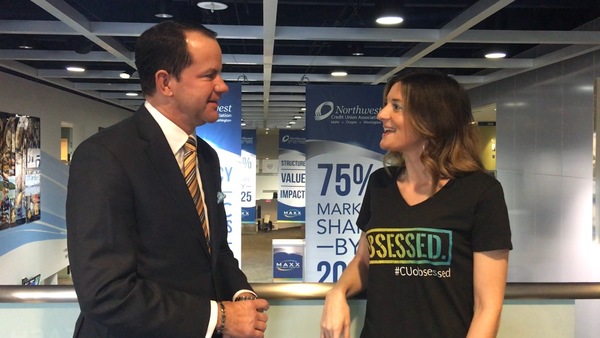 NWCUA CEO Troy Stang chats with CU Times Managing Editor Natasha Chilingerian at the MAXX Convention.
NWCUA CEO Troy Stang chats with CU Times Managing Editor Natasha Chilingerian at the MAXX Convention.Spokane, Wash. – In his President’s Address Wednesday morning at the Northwest Credit Union Association’s MAXX Convention, Troy Stang gave leaders from credit unions in Washington State, Oregon and Idaho an ambitious call to action: Increase their share of the Northwest market from 50% to 75% by 2025.
He listed member experience, advocacy and building consumer awareness as the three key focus areas that will help members of the Northwest credit union movement achieve that goal. “Knowing this crowd and this movement, I’d say, mission possible,” the association’s president/CEO said.
He said when it comes to capturing non-members, credit union leaders should keep in mind that members and non-members in fact have similar values – while non-members tend to be a bit younger than the typical credit union member, they are also tech-savvy, love all things local, want to be a part of something bigger than they are and want to get the best value out of their financial products. “We must elevate our passion around who credit unions are, and make sure everyone knows they have a choice to do business with a credit union and not a Wall Street bank,” Stang said.
Stang noted the biggest barrier to gaining more members – and a bigger share of members’ wallets – is a lack of consumer awareness about credit unions. Many consumers still don’t understand that credit unions are accountable to their members, and others have misconceptions that credit unions are only for the needy or that they are not safe and secure places to store one’s money, for example.
A key piece of successful credit union advocacy, he added, will be telling members’ personal success stories so that elected officials can fully understand the impact credit unions have on consumers’ lives. “We have to ignite the 25,000 people who work for credit unions in the Northwest [to tell those stories],” he said.


